Novelties
The Heisey Glass Company, founded in 1896 in Newark, Ohio, was known for producing high-quality, elegant glassware. Their pieces were often characterized by their clarity, brilliance, and intricate designs. Heisey's 'Crystolite' pattern, introduced in the 1930s, is particularly recognizable for its clear, pressed glass with a distinctive ribbed or paneled design.
This pattern was popular for a variety of serving pieces, including relish trays, bowls, and platters. The company ceased production in 1957, making their glassware increasingly collectible. Pieces like this relish tray are sought after for their vintage charm and the quality craftsmanship that Heisey was known for.
To inquire about pricing and availability, please email BALL HILL The Arcade at info@ballhill.com.
Measuring 16.75”x12”x8.5”
Daniel Marshall humidors are generally well-regarded for their classic look, quality construction, and ability to maintain consistent humidity. They are often praised for their high-gloss finish, solid wood construction, and well finished hardware.
Humidors are specialized storage containers designed to maintain a consistent level of humidity, typically around 70%, to preserve the quality of cigars. They are essential for preventing cigars from drying out, which can lead to a harsh taste and uneven burn. The use of Spanish cedar lining is common due to its moisture-retention properties and distinctive aroma, which complements the flavor of cigars.
Modern humidors often incorporate electronic monitoring and control systems to ensure precise humidity levels. These systems typically include a digital hygrometer and a humidification device that automatically adjusts to maintain the desired environment. High-end humidors may also feature advanced air circulation and filtration systems to further enhance the preservation of cigars.
To inquire about pricing and availability, please email BALL HILL The Arcade at info@ballhill.com.
Wesley & Bober, Inc. (Wesley Bober) is known for producing high-quality humidors and cigar accessories (France). Their humidors are often crafted with attention to detail and feature premium materials, such as Spanish cedar lining and precision hygrometers.
Humidors are specialized containers designed to maintain a specific humidity level, typically used for storing cigars, tobacco, or other moisture-sensitive items. The purpose of a humidor is to prevent the contents from drying out or becoming damaged by excessive moisture.
They are often made of wood, such as Spanish cedar, which helps regulate humidity and impart a pleasant aroma. The size of a humidor can vary greatly, from small portable cases to large, cabinet-style units. The dimensions provided (14"x9"x6.5") suggest a medium-sized humidor suitable for personal use or display.
The leather exterior adds a touch of elegance and sophistication, making it a desirable item for collectors and enthusiasts.
To inquire about pricing and availability, please email BALL HILL The Arcade at info@ballhill.com.
Stevens and Williams was a renowned British glass manufacturer celebrated for its innovative techniques and artistic designs during the Victorian era. Founded in the early 19th century, the company gained prominence for its exquisite cameo glass, intricate floral decorations, and vibrant color combinations.
Their creations often featured elaborate shapes and meticulous craftsmanship, reflecting the opulence and elegance of the period.
Victorian art glass baskets, like this one, were popular decorative items, showcasing the era's fascination with ornate designs and luxurious materials. These baskets were often used as centerpieces or ornamental displays, adding a touch of sophistication to Victorian homes. The combination of delicate glasswork and vibrant colors made them highly sought after collectibles
To inquire about pricing and availability, please email BALL HILL The Arcade at info@ballhill.com.
Collection of Modern Decorative Orbs
Decorative orbs and spheres have become increasingly popular in home decor, offering a versatile way to add texture, color, and visual interest to any space. These items are often used as bowl fillers, table centerpieces, or shelf accents, providing an easy and affordable way to update the look of a room.
Modern decorative orbs come in a wide variety of materials, including natural elements like wood, rattan, and dried botanicals, as well as manufactured materials like metal, glass, and plastic. The use of decorative balls as accents has grown significantly in recent years, reflecting a broader trend towards incorporating natural and organic elements into interior design.
To inquire about pricing and availability, please email BALL HILL The Arcade at info@ballhill.com.
Heisey Glass was produced from 1896 to 1957 in Newark, Ohio, by A.H. Heisey & Co. The company was known for its high-quality glassware, often featuring intricate designs and a distinctive clarity. Heisey's 'Plantation' pattern, introduced in the early 20th century, is characterized by its pineapple-like texture and elegant form.
These candle holders exemplify the craftsmanship and aesthetic appeal of Heisey Glass. The 'Plantation' pattern was popular for its unique texture and the way it reflected light, making it a sought-after item for collectors of vintage glassware. The design reflects the broader trend of incorporating natural motifs into decorative arts during the early to mid-20th century.
To inquire about pricing and availability, please email BALL HILL The Arcade at info@ballhill.com.
This Anheuser-Busch "After The Hunt" stein was produced in 1991 as part of a series of collectible beer steins. These steins were often commissioned to commemorate special events or to celebrate the company's heritage. They were typically made in limited editions, making them attractive to collectors.
Anheuser-Busch, the brewer of Budweiser, has a long history of producing collectible items, including steins, to promote its brand. The
"After The Hunt" stein features a detailed scene, likely inspired by classic hunting imagery, and is made with a combination of ceramic and metal components. While not exceptionally rare, these steins are sought after by collectors of breweriana and Anheuser-Busch memorabilia.
To inquire about pricing and availability, please email BALL HILL The Arcade at info@ballhill.com.
Pair of Tall Black Ceramic Obelisks (6.5" base x 31" tall).
To inquire about pricing and availability, please email BALL HILL The Arcade at info@ballhill.com.
Lemon Verbena Soy Candle
Specially made for BALL HILL The Arcade by the Timber Trail Candle Co.
To inquire about pricing and availability, please email BALL HILL The Arcade at info@ballhill.com.
This is a vintage Alva Museum Studio Aphrodite bust (circa 1980).
This sculpture appears to be a reproduction of a classical Greek or Roman face, possibly Aphrodite or Venus, given the serene and idealized features. The turquoise patina suggests an attempt to mimic the oxidation of bronze or copper over time, a common technique in reproduction art to give it an antique appearance.
Alva Museum Replicas, founded in 1948, was known for creating authorized reproductions of artworks from museums around the world. These reproductions were often made of materials like plaster or resin and then finished to resemble the original artifacts. The company aimed to make art accessible to a wider audience, allowing people to own high-quality replicas of famous sculptures and artifacts.
To inquire about pricing and availability, please email BALL HILL The Arcade at info@ballhill.com.
From the Collection of Michael Maher.
Cobalt ‘Flying Mare’, a Heisey mould reproduction made in 1993 by Dalzell Viking.
Heisey Glass was produced from 1896 to 1957 in Newark, Ohio, by A.H. Heisey & Co. The company was known for its high-quality glassware, often featuring intricate designs and a distinctive clarity.
To inquire about pricing and availability, please email BALL HILL The Arcade at info@ballhill.com.
These are hand-carved wooden book stands, likely of Indian or Southeast Asian origin.
Hand-carved wooden book stands have a rich history, particularly in regions with strong woodworking traditions. These stands are often used to hold religious texts, cookbooks, or other important documents, and they are valued for both their functionality and their decorative appeal. The intricate carvings often feature floral motifs, geometric patterns, or religious symbols, reflecting the cultural and artistic influences of the region where they were made.
Bohemian style, characterized by its eclectic mix of patterns, textures, and cultural influences, has seen a resurgence in popularity in recent years. Vintage hand-carved book stands fit well within this aesthetic, adding a touch of global flair and artisanal craftsmanship to any space. These pieces are appreciated for their unique character and the stories they tell through their intricate carvings.
Origin: India or Southeast Asia (Mid 20th Century)
To inquire about pricing and availability, please email BALL HILL The Arcade at info@ballhill.com.
This is a bronze sculpture of a cowboy on a bucking bronco, by Carl Kauba.
Bronze sculptures depicting cowboys and scenes from the American West gained popularity in the late 19th and early 20th centuries, capturing the spirit of the frontier.
Artists like Frederic Remington and Charles Marion Russell helped to define this genre, creating iconic representations of cowboys, Native Americans, and the landscapes of the West. These sculptures often celebrated the rugged individualism and adventurous spirit associated with the era.
Carl Kauba was an Austrian sculptor known for his detailed bronze figures, many of which depicted scenes from the American West. His works often featured cowboys, Native Americans, and other characters, rendered with a high degree of realism and dynamism.
Kauba’s sculptures were popular among collectors and helped to spread the romanticized image of the American West throughout Europe.
Made in Austria (likely).
To inquire about pricing and availability, please email BALL HILL The Arcade at info@ballhill.com.
Tall Carrara Marble Vase
18” H x 7” D
Marble vases have been used for decorative and functional purposes since ancient times, with examples found in various cultures, including ancient Greece and Rome. Carrara marble, sourced from Carrara, Italy, is particularly prized for its purity and fine grain, making it a popular choice for sculptures and architectural elements. The use of marble in vase design reflects a desire for elegance and durability, as well as an appreciation for the natural beauty of the stone.
In modern times, marble vases continue to be produced, often drawing inspiration from classical forms while incorporating contemporary design elements. These vases can range from simple, minimalist designs to more elaborate, sculptural pieces.
Patinated Copper Molded Horse, Racer and Sulky Weathervane
Patinated copper molded figural seated harness racer on a sulky and running horse. 20th century production with directional and stand. Weathervane measures 18"H x 33.5" x 11. Stand 56" x 10.5" x 8" directional coiled 22 3/4" .
Highly unique. Used showing wear.
To inquire about pricing and availability, please email BALL HILL The Arcade at info@ballhill.com.
Contemporary Woodstock Wind Chimes Gong
A calligraphy inspired black finish ash wood, brass gong (50").
Woodstock Gongs are hand-hammered by a master gong maker with materials that have gone into crafting gongs for thousands of years, so each one delivers a rich, authentic sound.
To inquire about pricing and availability, please email BALL HILL The Arcade at info@ballhill.com.

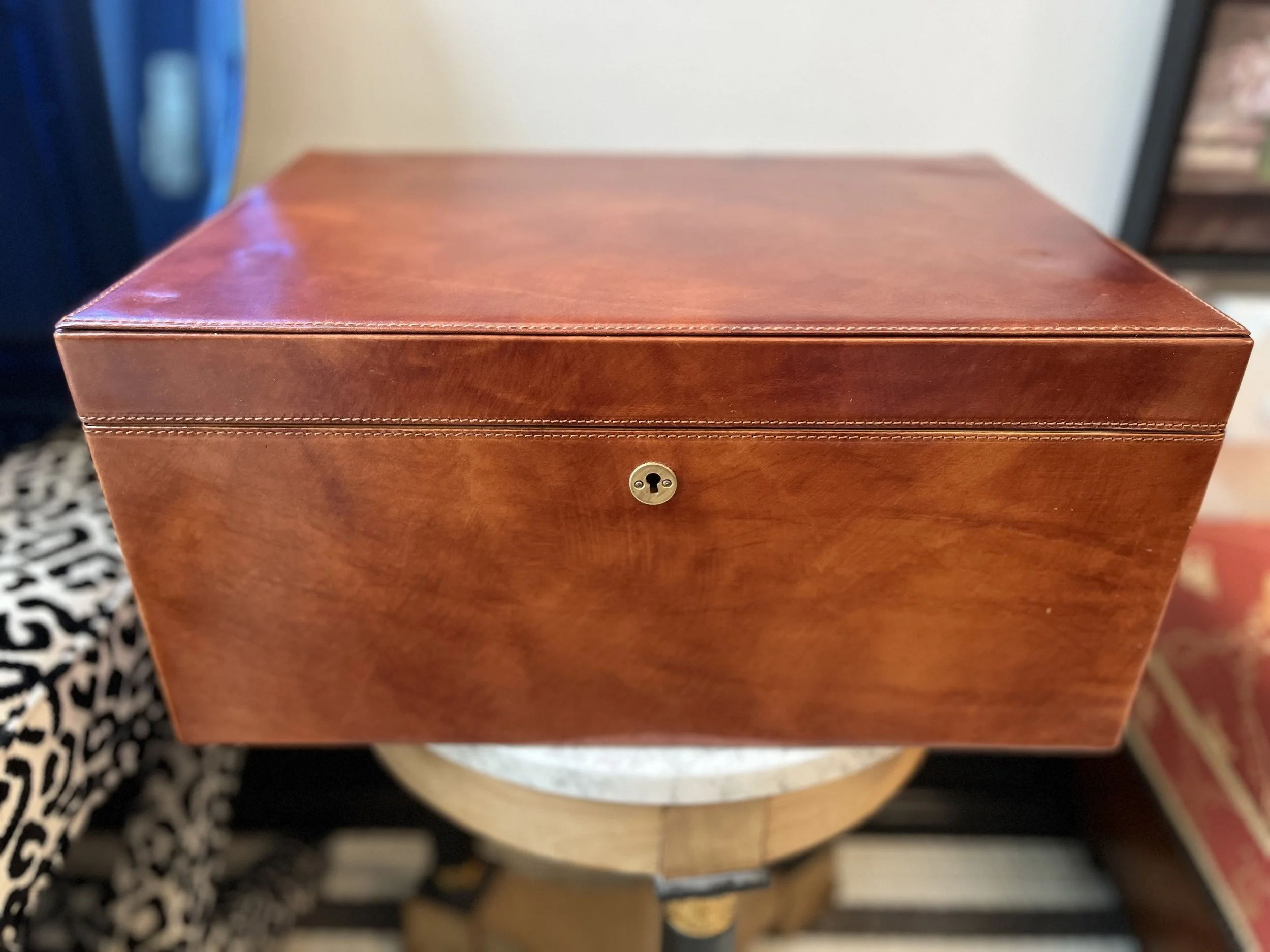

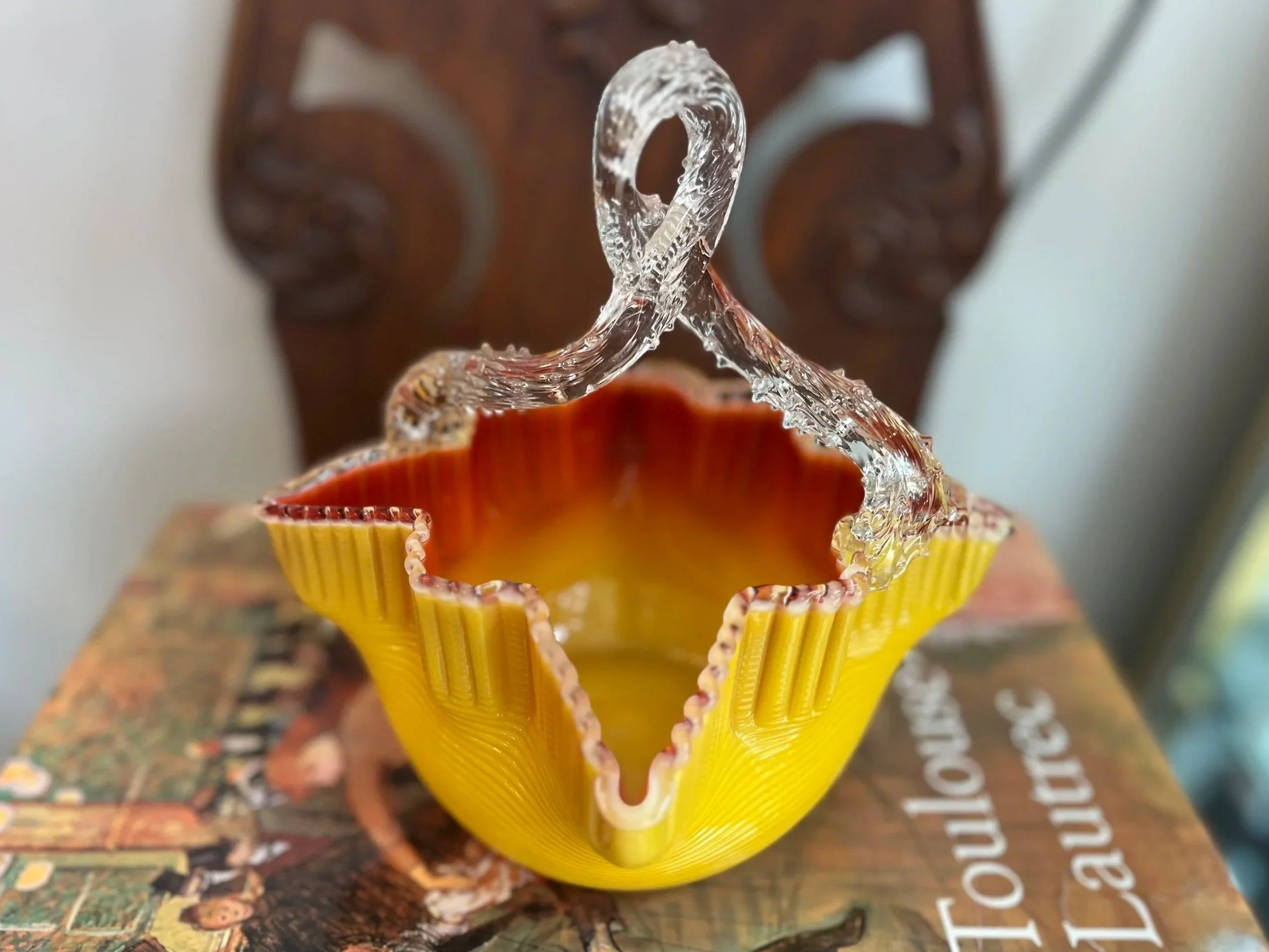


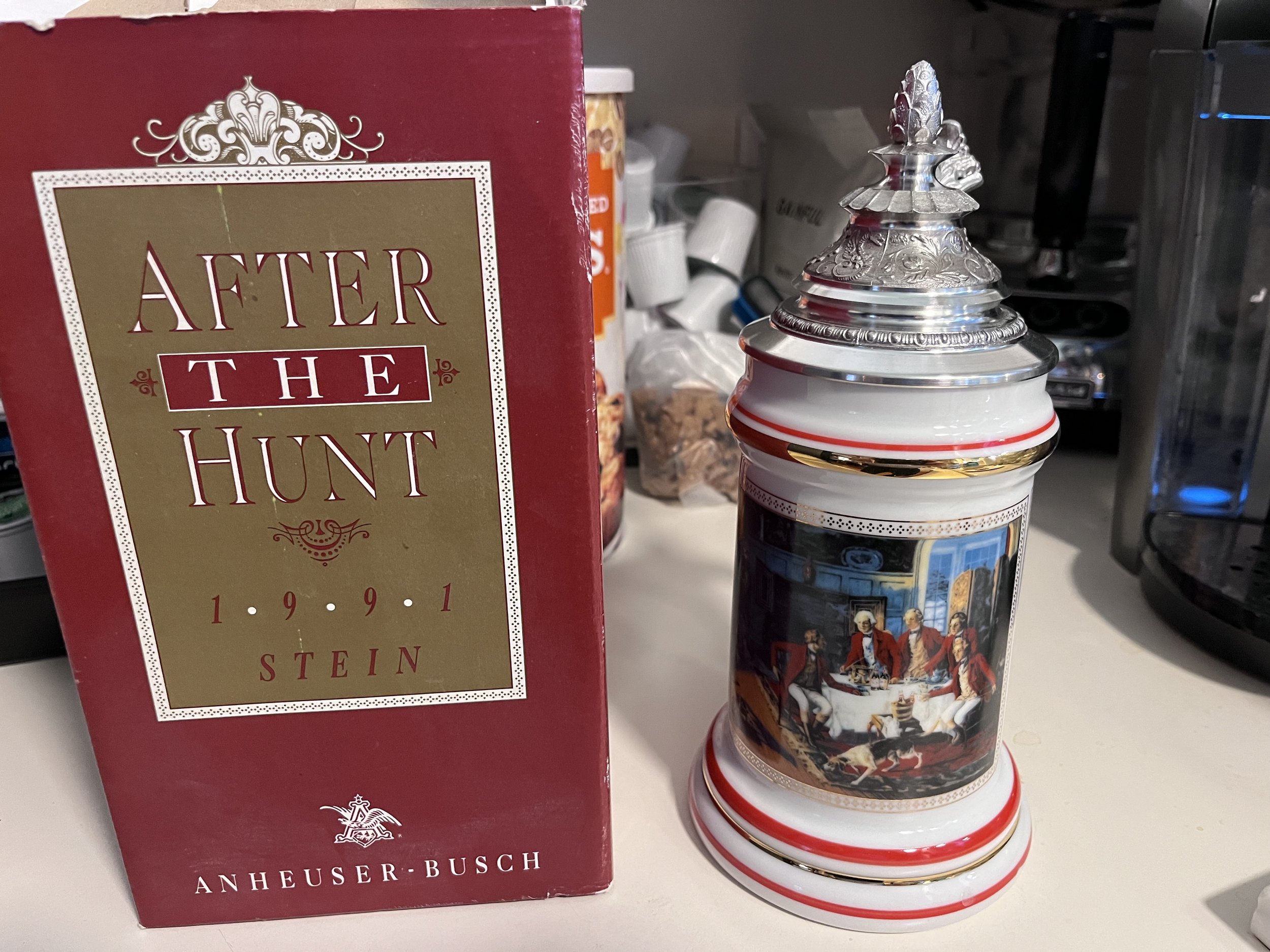


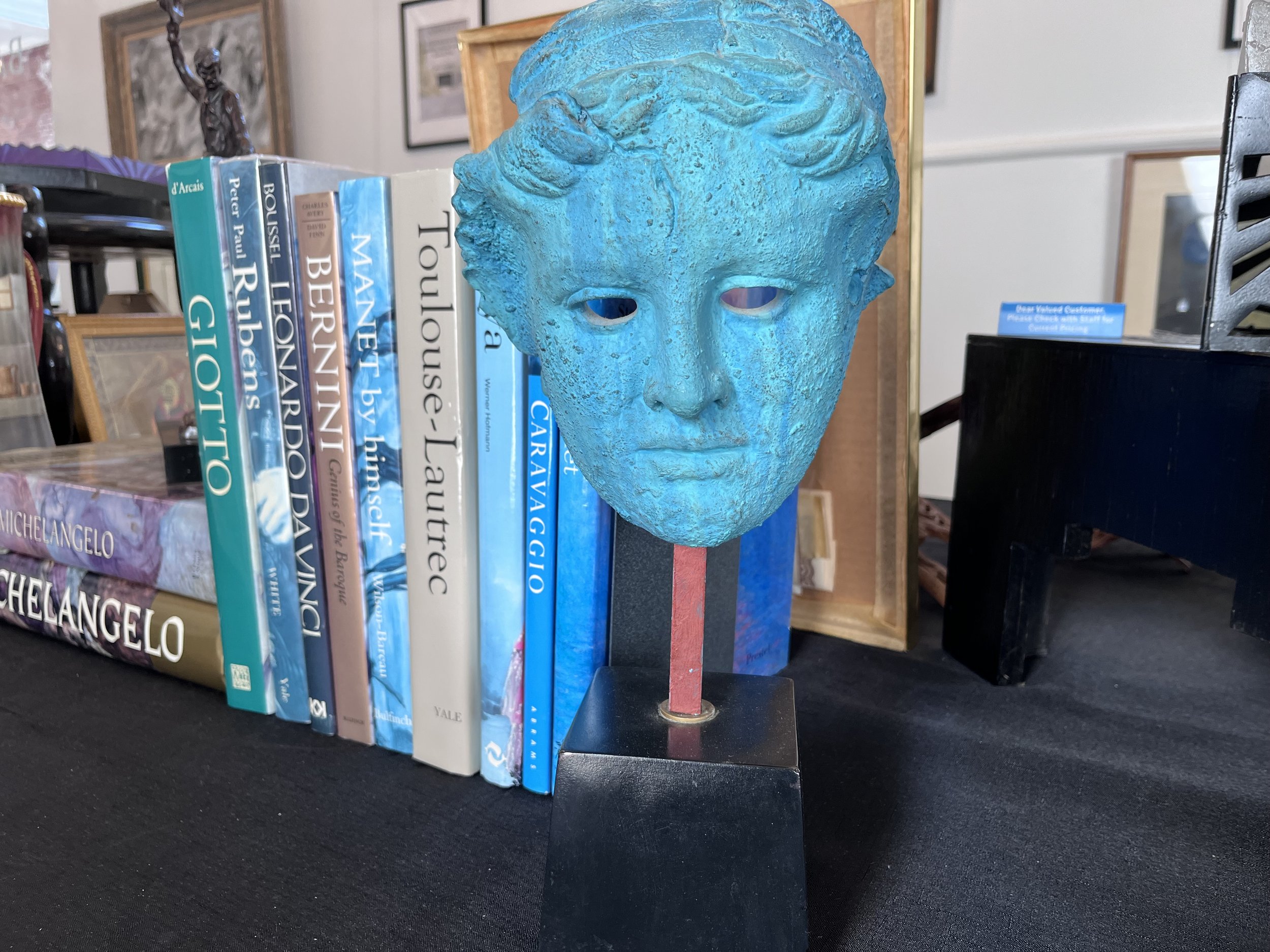
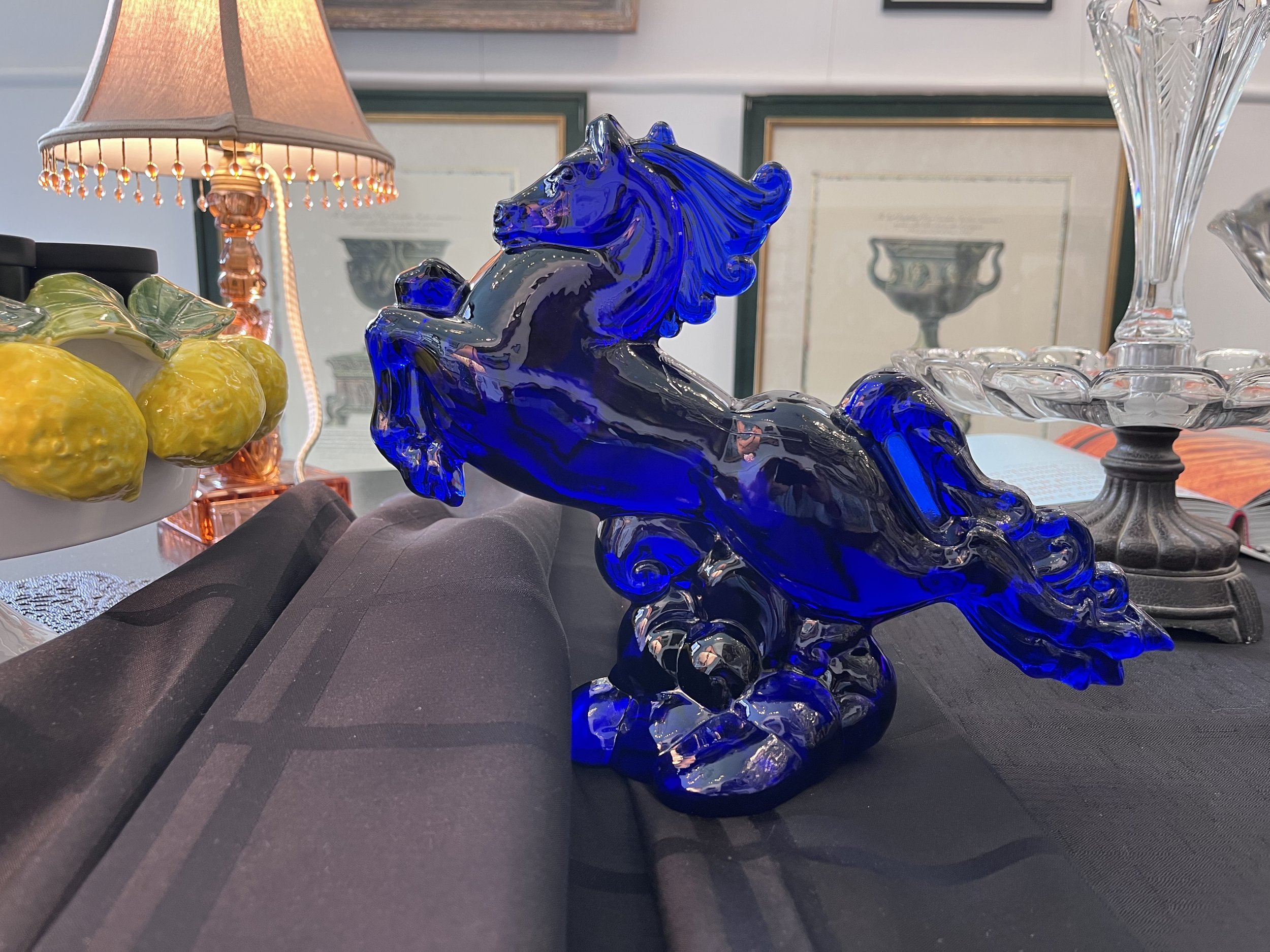





Heisey Glass Company, founded in Newark, Ohio, in 1896, was known for producing high-quality, elegant glassware. Their Crystolite line, introduced in the early 20th century, was particularly popular for its clarity and intricate designs. Heisey pieces are often collected for their distinctive molds and the company's commitment to craftsmanship.
This particular leaf-shaped dish is a classic example of Heisey's Crystolite pattern, showcasing the delicate ribbing and clear glass that defined the line. These dishes were commonly used as nut dishes or small serving pieces, adding a touch of sophistication to any table setting. Heisey ceased production in 1957, making their pieces increasingly sought after by collectors.
To inquire about pricing and availability, please email BALL HILL The Arcade at info@ballhill.com.